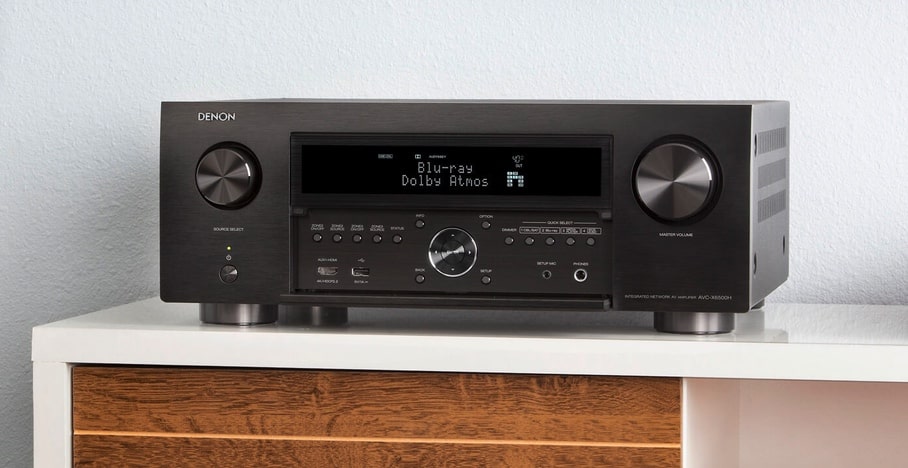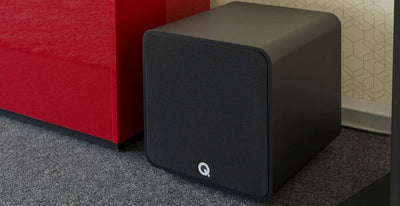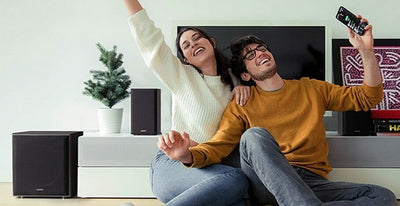Choosing your home cinema components may seem daunting at first however once you understand the main components and how they fit together it all becomes a lot clearer.
This guide is the first in our home cinema series and is designed to give you an overview of a home cinema system, let’s not worry too much about Dolby Atmos and speaker setups just yet.
We’ll link out to specific more detailed guides on these areas but first let’s break it down into the three main components that you’ll need before deciding on which items you go for.
Home Cinema Components

AV Receiver
The AV receiver is the heart of your home cinema system and is where each individual speaker wires back to.
It powers all of your speakers, it receives all of your audio and video content (i.e Bluray player, games consoles etc) and outputs it to your TV or projector.
It decodes the sound from the audio source and outputs it to the speakers.
Without this receiver you don’t have a home cinema system, so without a doubt you’ll need an AV receiver in your home cinema system.
You’ll find a wide range of brands on the market including Onkyo, Denon, Yamaha, Sony and many more. Most have a similar set of features, especially when it comes to the surround sound aspect, but you’ll also find wireless music streaming functions that may be of additional benefit and offer greater value for money.
For instance with Denon’s HEOS technology you can easily play music from your smartphone or tablet through your surround sound speakers, without having to turn the TV on!
You’ll also find Airplay, Spotify Connect, Bluetooth and more so make sure to check the specs of each AV receiver, spending a few pounds more may actually offer much greater value overall.

Surround Sound Speakers
This is where most people will start, and often the most fun part, choosing your speakers!
Surround sound speakers come in various sizes and formats including;
- Bookshelf Speakers
- Floorstanding Speakers
- In Wall Speakers
- In Ceiling Speakers
- Soundbars (Active & Passive)
The first step is to really understand what type of speakers you want.
Are you going for a discreet home cinema with no speakers on show? Then look for custom installed wall and/or ceiling speakers.
Got plenty of room and want to make a statement whilst offering ultimate sound quality? Floorstanding speakers are the way forward.
We have a range of surround sound packages that have all the matching speakers bundled together ready to go, just add an AV Receiver!
Speaker Layouts
We’ll cover speaker layouts in more detail in another guide, but when first learning about home cinema you need to understand the basics.
Surround sound systems will consist of multiple speakers, as a minimum you’ll need;
- Front Left
- Front Right
- Centre
- Rear Left
- Rear Right
When planning a surround sound system you’ll need to allow for a minimum of five speakers.
Depending on your budgets, room sizes and requirements you can expand on this with Dolby Atmos or a 7.1 setup, but five speakers is your minimum for a surround sound system.
It is of course possible to have a two or a three speaker setup, but we tend to class this as a TV Sound system rather than a surround sound system so we’ll cover that in another guide.
Mixing Speakers
You can also mix and match speakers to build the perfect system.
We will normally recommend trying to stick with the same brand / range to ensure an audio match but it’s quite common to have in wall speakers at the front and in ceiling speakers at the rear, or floorstanding speakers at the front and bookshelf speakers at the rear.
You’ll use a different “centre” channel speaker at the front too, we always recommend from the same range. For instance if you go for Q Acoustics Concept 30 bookshelf speakers for your front left and right then we’d recommend the Q Acoustics Concept 90 centre channel speaker.
When going for in wall or in ceiling speakers then always stick to the same speaker / range. I.e using the same LCR speakers for front left, centre and right or using for instance Monitor Audio W260’s left and right and a W250LCR for the centre channel.

Subwoofer
You can’t have a surround sound speaker system without a subwoofer!
Well, technically you can and it’s not too uncommon, but adding a subwoofer to your surround sound speaker system is as easy as plugging it into the AV receiver and it’ll “bring the bass”.
Subwoofers will add significant depth and realism to your movies (and music) which completely transforms your home cinema experience.
Most commonly you’d opt for an active subwoofer which plugs into your AV receivers subwoofer output with a subwoofer cable. Easy to install and setup but absolutely transformational!
You can find a more detailed guide to subwoofers here.

TV / Projector
The final component to your ultimate home cinema is the video source, TV or projector!
Your TV or Projector will plug into the AV receiver and display video content from anything plugged into the AV receiver, for instance a bluray player or games console.
The sound will then come from the surround sound speakers instead of the TV.
Most modern TV’s can also control the AV receiver from the standard TV remote so it turns on automatically and volume adjusts from the TV remote, you’ll just need to switch between video sources.
Projectors work in exactly the same way, albeit you’ll need to use the individual remote controls or a universal remote control as the projector won’t control the AV receiver.
Also consider how you will be enjoying your content.
Projectors tend not to have any built in multimedia so you’ll need to plug in a video source to the AV receiver, for instance a Fire Stick, media streamer, bluray player or games console.
TV’s now have most smart streaming services built in, but to play the sound through the AV receiver you’ll need to use a HDMI cable and ensure your TV supports “ARC” (Audio Return Channel) which sends the TV sound to the AV receiver.
Conclusion
So in conclusion, a basic home cinema system will have;
- An AV Receiver
- A minimum of 5 speakers wired back to the AV receiver
- A TV or projector plugged into the AV receiver
- Visual Sources - be it Bluray player, games console or apps on your Smart TV.
Hopefully you now understand the basics of what’s required and you can explore each individual component in great detail with a better understanding of how they go together.
We recommend designing your home cinema in the following way;
- Determine the type of speakers you want (bookshelf/in ceiling/etc)
- Determine the number of speakers & layout (5.1/7.1/Atmos)
- Determine the video source (TV / Projector) and where the components will sit in your room
From there you can pick your speakers, AV receiver and plan the wiring to make it all work.
One last tip for you, with surround sound often quality is better than quantity. If your room doesn’t suit Dolby Atmos, don’t try to force it. If you can’t fit 7.1, don’t try to force it. You may find a much better experience by using the full budget on a higher quality 5.1 surround sound setup instead.
Our audio experts are on hand to help you design the ultimate home cinema system by email, live chat or by calling 02393 190955.





